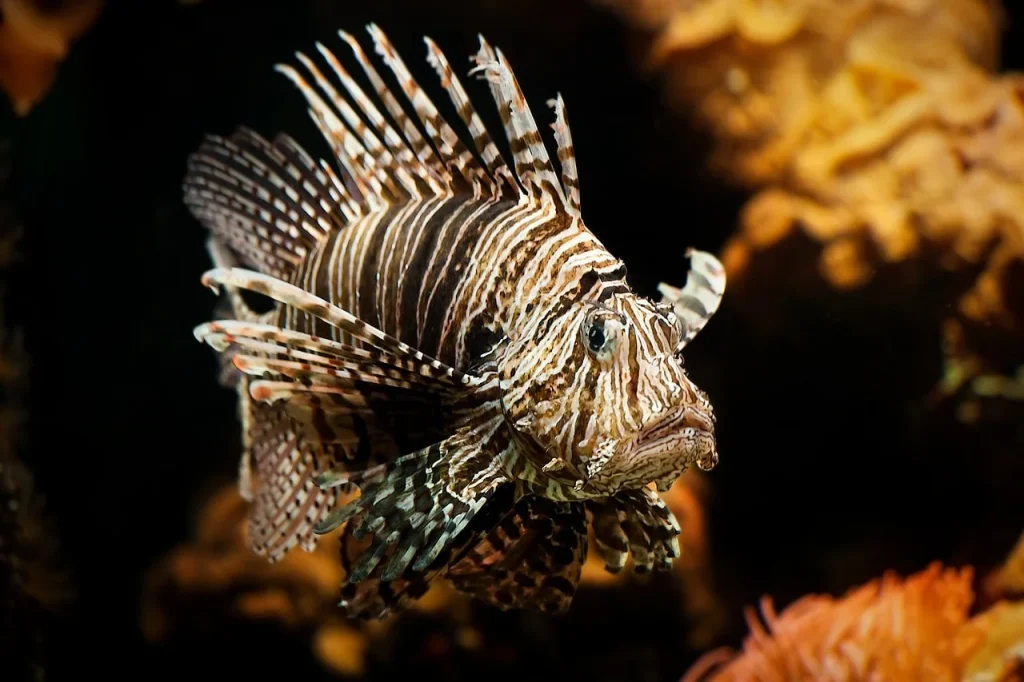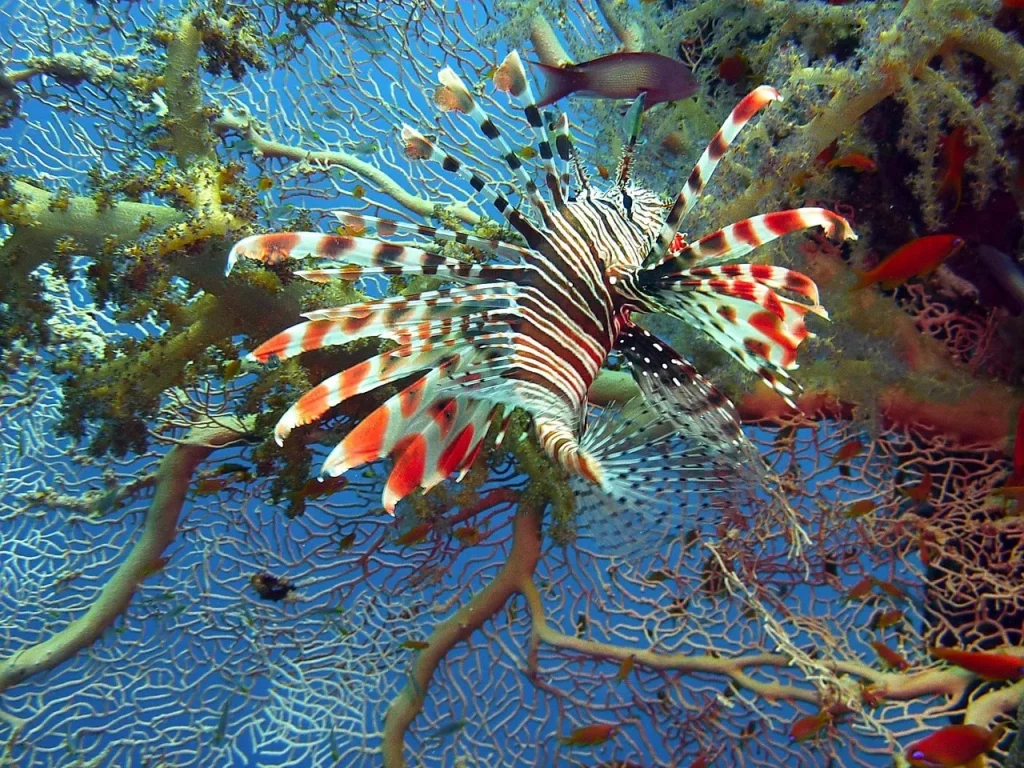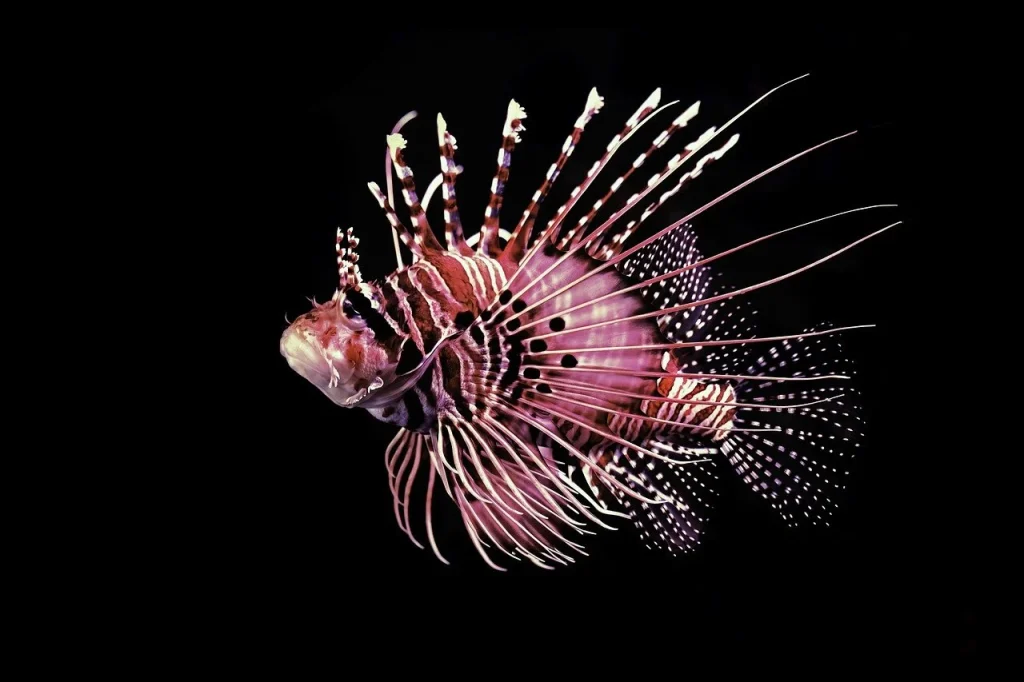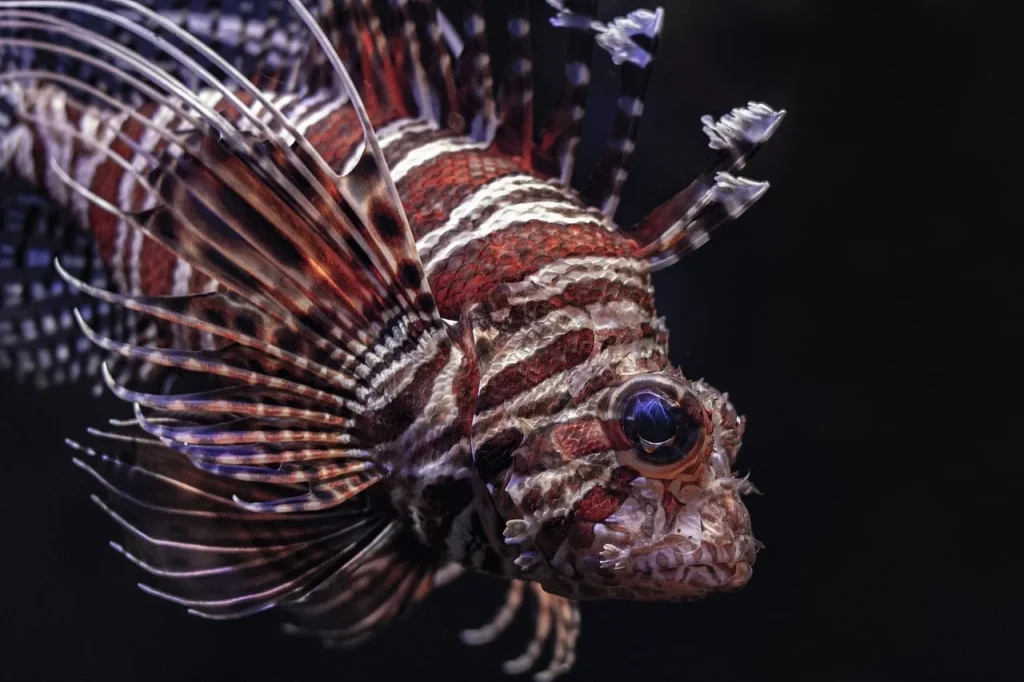Lionfish are a perfect example of how appearances can be deceiving. Their striking beauty hides a predatory nature that has caused havoc in marine environments. Originally from the Indo-Pacific, these fish have spread to the Atlantic, where they have no natural predators.
In this article, we’ll uncover some fascinating facts about lionfish, from their hunting strategies to their impact on local fish populations.
Lionfish are the most beautifully dangerous invaders of the ocean.
Jean-Michel Cousteau
Lionfish Facts
Let’s start our journey into the world of lionfish where beauty meets danger in the depths of the ocean. Read each fact carefully because there is a quiz at the end of this page to test your knowledge.
- Venomous spines on their dorsal fins can cause extreme pain, nausea, and even temporary paralysis.
- They can live in a wide range of salinities, from brackish waters to full marine environments.
- Their invasion in the Atlantic is one of the most significant marine biological invasions to date.
- In their native range, they face predation from sharks and large groupers, but in the Atlantic, they have very few natural predators.
- They can consume prey up to half their size, showcasing their voracious appetite.
- Rapid reproduction allows them to quickly establish large populations in new areas.
- Females can spawn every four days, producing over two million eggs per year.
- Their larvae can disperse over long distances, aiding in their spread across vast oceanic areas.
- Colorful patterns serve as a warning to potential predators about their venomous nature.
- They exhibit a unique hunting strategy called “herding,” where they corner prey using their large pectoral fins.
- In the Atlantic, they have been found at depths of over 1,000 feet.
- Their venom contains a potent mix of proteins, including a neurotransmitter inhibitor.
- They can tolerate a wide range of temperatures, from tropical to subtropical waters.

- Juveniles often find refuge among mangroves and seagrass beds, which serve as important nursery habitats.
- Their diet includes over 70 different species of fish and invertebrates, highlighting their impact on reef biodiversity.
- They have a remarkable ability to adapt to various environments, including artificial structures like shipwrecks and oil rigs.
- Voracious appetites lead to significant declines in native fish populations where they invade.
- Some reef fish have been observed learning to avoid them, demonstrating adaptive behavior in response to the invasion.
- Their spines can remain venomous for days after being detached from the body.
- They have been known to exhibit cannibalistic behavior in the absence of other prey.
- DNA analysis reveals that most Atlantic populations originated from just a few individuals, showing a high level of genetic similarity.
- Rapid growth rates enable them to reach maturity quickly, often within a year.
- They can switch between active hunting during the day and ambush tactics at night.
- In their native Indo-Pacific range, they play a balanced role in the ecosystem, unlike in the Atlantic where they cause disruption.
- Their venom has been studied for potential medical applications, including pain relief and anti-cancer properties.
- Some scuba divers and snorkelers have started participating in “lionfish derbies” to help control their populations.
- They have a unique ability to inflate their stomachs to gulp down large prey.
- Marine scientists have documented instances of them hitching rides on ocean currents to new locations.

- Invasive populations have been found as far north as Long Island, New York, demonstrating their cold tolerance.
- They can survive without food for extended periods, making them resilient invaders.
- Parrotfish and eels have been observed occasionally preying on them in the Atlantic.
- Studies have shown that they can reduce juvenile fish populations on reefs by up to 90%.
- They exhibit a behavior known as “blowing,” where they use jets of water to disorient and capture prey.
- Specialized cells in their spines produce the venom, which is then delivered through grooves in the spine.
- Efforts to train native predators to hunt them have shown mixed success but represent a creative approach to management.
- Their pectoral fins are used not just for swimming but also for creating barriers to corral prey.
- They have a lifespan of up to 15 years in the wild.
- Invasive populations are more aggressive than those in their native range, possibly due to fewer predators.

- Their skin secretes mucus that can help protect them from parasites and infections.
- They are capable of rapid color changes to blend into different environments and avoid detection.
- In some areas, local fishers have begun to market them as a delicacy, promoting their consumption as a control method.
- They exhibit a high degree of site fidelity, often returning to the same hunting grounds day after day.
- Some researchers are exploring the use of underwater robots to help cull their populations.
- When threatened, they display their spines in a fan-like manner to ward off potential threats.
- They have an extensive range of movements, including the ability to swim backwards using their pectoral fins.
- In addition to their ecological impact, they can cause significant economic damage to fisheries and tourism industries.
- Efforts to create lionfish-specific traps are underway to improve control efforts in deep waters.
- Their venom remains potent even at extreme depths and pressures, an adaptation to their versatile habitat range.
- Research is ongoing to better understand their impact on coral reef health and recovery dynamics.
- While they pose a threat to many reef species, they also have become a popular subject for underwater photographers due to their striking appearance.
Lionfish Myths

Now that we’ve explored the facts, let’s continue into separating the myths from the truth. There’s a lot of misinformation out there, and we’re here to clear it up.
- Lionfish Are Native to the Atlantic Ocean
They actually originate from the Indo-Pacific oceans. They have become invasive in the Atlantic due to aquarium releases. Their adaptability and rapid reproduction allow them to thrive in non-native waters. - Lionfish Have No Natural Predators
In their native habitats, larger fish and eels often prey on lionfish. However, in the Atlantic, where they are invasive, fewer predators recognize them as food, allowing their populations to grow unchecked. - Lionfish Poison Their Prey
They don’t poison their prey; instead, they use their venom defensively. Their sharp spines deliver venom when threatened, which is painful to humans but not deadly. - Lionfish Venom is Fatal to Humans
While lionfish stings are venomous and can cause significant pain, swelling, and even illness, they are rarely fatal to humans. Medical treatment is advised to manage symptoms effectively. - There is No Way to Control Lionfish Population
Efforts to manage lionfish populations include spearfishing and encouraging consumption. Their meat is tasty and safe to eat once the venomous spines are removed, making them a target for sustainable fishing practices.
Lionfish Quotes

Below you will find some of my favorite quotes. Feel free to share yours in the comments so I can add them to the list.
The lionfish is a perfect example of how a single species can disrupt an entire ecosystem.
Sylvia Earle
Sylvia Earle, a marine biologist, uses lionfish to illustrate the significant impact one species can have on its environment.
Lionfish are a voracious predator, eating anything that fits in their mouth.
Zeb Hogan
Zeb Hogan, a fish biologist, describes the insatiable appetite of lionfish and their predatory behavior.
Introducing lionfish to new habitats has been like opening Pandora’s box.
David Doubilet
David Doubilet, an underwater photographer, compares the introduction of lionfish to unleashing unforeseen problems.
Lionfish teach us a crucial lesson about the consequences of introducing non-native species.
Paul Greenberg
Paul Greenberg, an author and environmentalist, emphasizes the broader implications of non-native species through the example of lionfish.
The spread of lionfish is a call to action for better marine conservation efforts.
Enric Sala
Enric Sala, a marine ecologist, uses the proliferation of lionfish as a rallying point for improving conservation strategies.
Lionfish FAQ

As we are getting closer to the quiz, remember to pay attention to the FAQ section. These last details are going to help you ace the quiz.
- Are lionfish poisonous?
Yes, they are poisonous. They have venomous spines that can deliver a painful sting. The venom is used primarily for defense and can cause severe pain and swelling in humans. - Can lionfish kill you?
It’s very rare. While a lionfish sting can be extremely painful and potentially cause severe reactions, it is seldom fatal to humans. However, anyone stung should seek medical attention as reactions can vary. - Are lionfish edible?
Yes, they are edible. In fact, they are considered a delicacy in many parts of the world. Their meat is light and flaky, and they are often promoted as a sustainable seafood choice, particularly in areas where they are an invasive species. - Can lionfish live in freshwater?
No, they cannot survive in pure freshwater. They are saltwater fish, though they have been known to venture into brackish waters (a mix of salt and freshwater) near estuaries. - How do lionfish impact local ecosystems?
They are invasive in many environments and can have a devastating impact on local ecosystems. They are prolific breeders and voracious eaters that compete with native species for food and habitat, often leading to decreased biodiversity.
Lionfish Trivia

Welcome to our lionfish quiz! Dive in and see if you can conquer these spiky questions. Fair warning, if you don’t get any right, you might just find your bathtub invaded by these stripey interlopers tonight!
Conclusion
Ending our exploration of lionfish, we’re reminded of the intricate dance between invasive species and native habitats. It’s a complex issue, but by spreading awareness and supporting reef conservation, we can make a difference.
Remember, every small action counts towards a larger impact on our planet’s health. Till next time, stay curious and explore more. Cheers.


